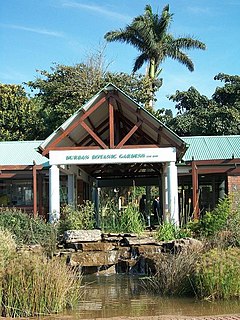Durban Botanic Garden
| Durban Botanic Gardens | |
|---|---|

The new entrance to Durban Botanic Garden
|
|
| Type | Botanical |
| Location | Durban, South Africa |
| Coordinates | 29°50′48″S 31°00′24″E / 29.84667°S 31.00667°ECoordinates: 29°50′48″S 31°00′24″E / 29.84667°S 31.00667°E |
| Area | 15 hectares |
| Founder | 1851 |
| Website | www |
The Durban Botanic Gardens is situated in the city of Durban, KwaZulu-Natal, South Africa. It is Durban’s oldest public institution and Africa's oldest surviving botanical gardens. The gardens cover an area of 15 hectares (37 acres) in a subtropical climate.
The Durban Botanic Gardens was established to participate in the quest of Kew Gardens to establish a series of botanic gardens across the world which would assist in the introduction of economically valuable plants, and to supply plants to Kew that were new to science. The first garden was established in December 1849 by Dr Charles Johnston on the edge of the Berea Ridge next to the Umgeni River (near Quarry Road). He was in charge of the gardens for less than 1 year. A Scot called Mark McKen then took his place and began to establish gardens of plants of economic value such as sugar cane, tea, coffee and pineapples. In 1851 the botanical gardens were relocated closer to town, to its present site. From 1853 to 1860 there were various curators, the most notable of which was Robert Plant, who died of malaria while collecting plants near Lake St. Lucia. McKen then returned in 1860 and was the curator for the next 12 years; until his death in 1872.
A German by the name of William Keit arrived from Glasnevin in Ireland to take over the curatorship of the gardens, but economic depression in Natal, a drought, and the Anglo-Zulu War took its toll. Keit resigned in 1881 to become a nurseryman and was later Durban’s first director of parks.
...
Wikipedia
